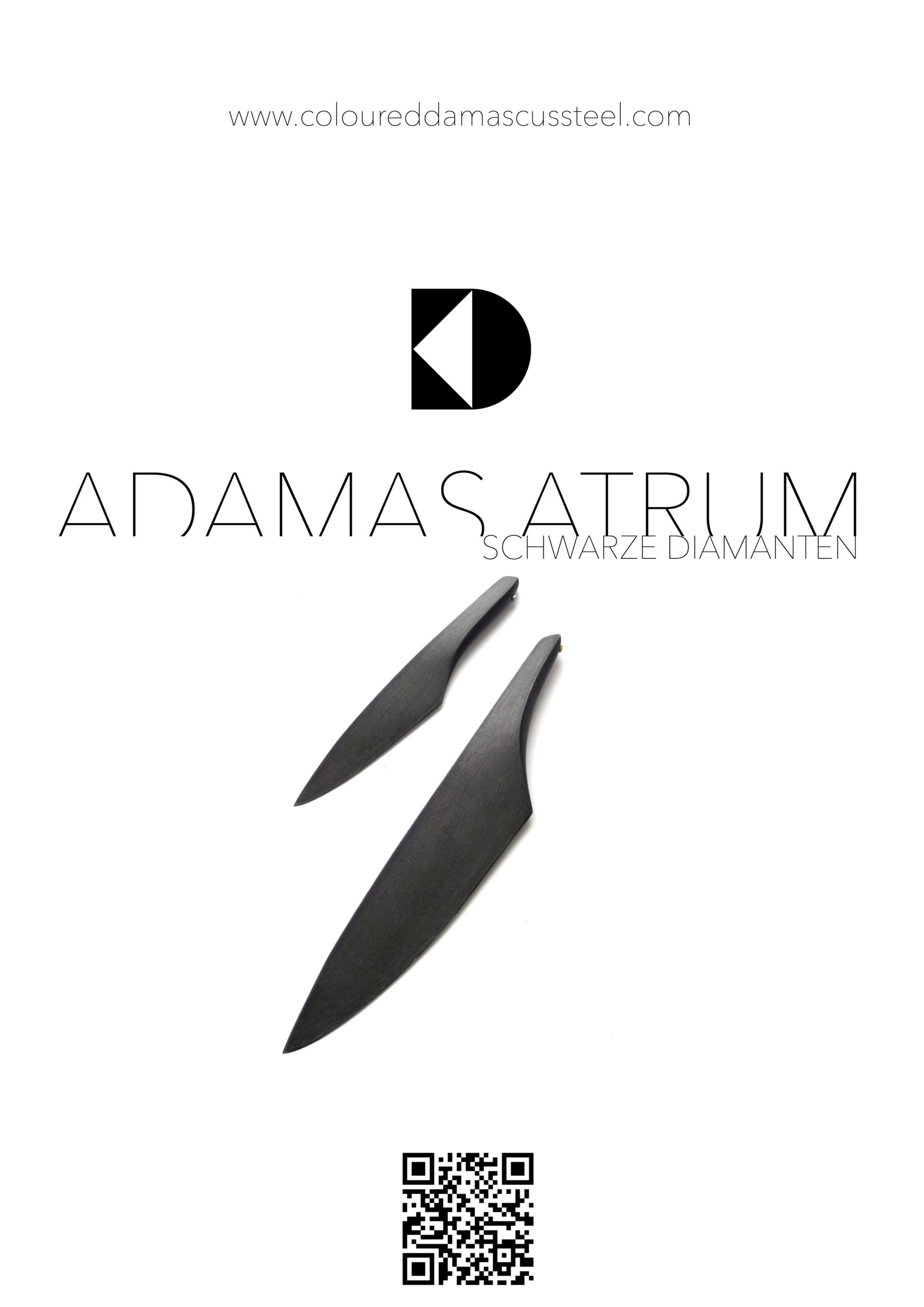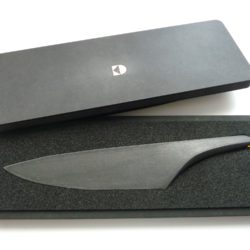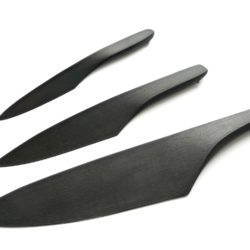“ADAMAS ATRUM – schwarze Diamanten” CHEFKNIFE SERIE AUS DAMASZENERSTAHL, PROFIKOCHMESSER MIT MODERNEN BESCHICHTUNGSTECHNOLOGIEN
Description
Knife set made of DLC (diamond-like carbon coating) coated mono- and damascus steel for professional and hobby cooks. The resulting knives are so-called all-steel blades forged from one piece.What is the Topic?
Damascus steel is known to many as a composite material of different types of steel and the pattern that accompanies it, which is reminiscent of wood grain. Damascus steel is generally used to make smaller objects, mainly cutlery and knives. Jewellery and other accessories made of Damascus are also not uncommon. Knives made of mono as well as Damascus steel, which are functional, look good and cut enormously well, are often offered on the market. However, knives that elude the classic combinations in the choice of materials for handle and blade are rather rare and even rarer ergonomic or practical. In addition, most knives for the kitchen are based on common examples of Asian knife types and are almost always manufactured according to these specifications. Notable further developments of classic knife categories are also rather rare and are not well received on the market, as the majority of the target group "professional and hobby chefs" prefer traditional knife shapes and have to be convinced of new products in particular. The main aim of this work was to create a concept for equipping professional chefs with knives that combine a high degree of design quality with technical and ergonomic perfection. It should be clarified which technologies can be used in the tool system knives, which have not been considered so far, in order to increase the cutting performance of the blade/cutting edge and/or to facilitate handling. On the one hand, it should be analysed how the acceptance of the target group towards new technologies is structured, as well as what requirements the target group (cooking in the kitchen and cooking in show cooking) has for the shape/design of a blade, or whether the knife is also accepted and used as a luxury object in private professional kitchens, to round off the status symbol "kitchen". I wanted to explore under which aspects a professional chef's knife made of Damascus steel can be designed to trigger strong, positive emotions without triggering a controversial perception that negatively influences the extraordinary design of knives made of Damascus steel. The object aesthetics should be in focus and convey the sensible use of modern technologies in relation to the design and manufacture of a chef's knife set. Also the name of the knife set, the packaging and the integration of a logo were essential parts of this work to emphasize the value of the knives. The blades shown here have been coated with a diamond-like carbon coating (DLC) at the Fraunhofer IST, Institute for Coating and Surface Technology in Braunschweig, Germany, to improve sliding properties and make a tool steel that is actually prone to corrosion resistant. This considerably simplifies the maintenance of the objects. The dark grey to anthracite coloured surface harmonises with the topological features of the blades and thus creates a discreet but striking elegance. These blades not only stand for the preservation and further development of an old, handcrafted cultural asset, but also convey uniqueness, value and luxury in a special way through the materials, working techniques and technologies used.
Why does it look like this?
Whole steel blades are characterized by the fact that they do not have an explicit wooden handle and only their topological properties generate ergonomics and safe handling. In the context of this work I wanted to find out which influences e.g. a DLC coating (DLC=Diamont Like Carbon) will have on the overall concept. Due to the DLC-coating used, the steel feels very soft and velvety and gets a noble, dark grey colouring of the surface. The reason why I produce the majority of my blades as all-steel knives is also due to the possibility of a much larger projection surface for pattern and colour. This allows the shape and the surface of the knife to be shown to advantage in a very special way. A triad of pattern (surface), form and colour is created!
What is special?
The pattern and structure of the damask semi-finished products are not random, but fulfill a technological and design purpose. The relief of the pattern on the damasked blades contributes to safe handling and prevents slipping off the handle area, especially when cutting with a lot of pressure. The blade made of mono-steel is of course not unsafe to handle, but it is also not designed to withstand a lot of pressure on the material to be cut. The damask bar as a semi-finished product of the damask blades consists of adjacent strips and, seen from the front side, is constructed similar to a checkerboard pattern. This preliminary stage of a mosaic damascus is further processed in such a way that the strips of which the ingot is made, like fibres, extend from the back to the front in the direction of the blade tip, which becomes increasingly finer as the blade is forged. Surprisingly, the resulting pattern is very remotely reminiscent of Arabic calligraphy and is at the same time a work trace documenting the creation of the blade. The association of the resulting, striped pattern with writing sets the damascus unobtrusively and nobly in scene. The technical reason for choosing this fibrous damask material is the higher flexibility and stability of the finished product.
What is new?
think I have succeeded in conveying and implementing luxury, uniqueness, elegance and value in a special way with the results of this work. With this I have created a special unique selling point for my blades, which does not exist in this form on the market. In addition to my patent (object made of Damascus steel, which was granted to me in 2017 and which deals with the coloured design of Damascus steel), I have enriched the thematic complex of Damascus steel with a further and interesting aspect in dealing with this ancient cultural asset. The combination of old craftsmanship and modern technologies generates something independent and absolutely new.




